jump start MAZDA MODEL 3 HATCHBACK 2005 Owner's Manual (in English)
[x] Cancel search | Manufacturer: MAZDA, Model Year: 2005, Model line: MODEL 3 HATCHBACK, Model: MAZDA MODEL 3 HATCHBACK 2005Pages: 322, PDF Size: 4.7 MB
Page 118 of 322
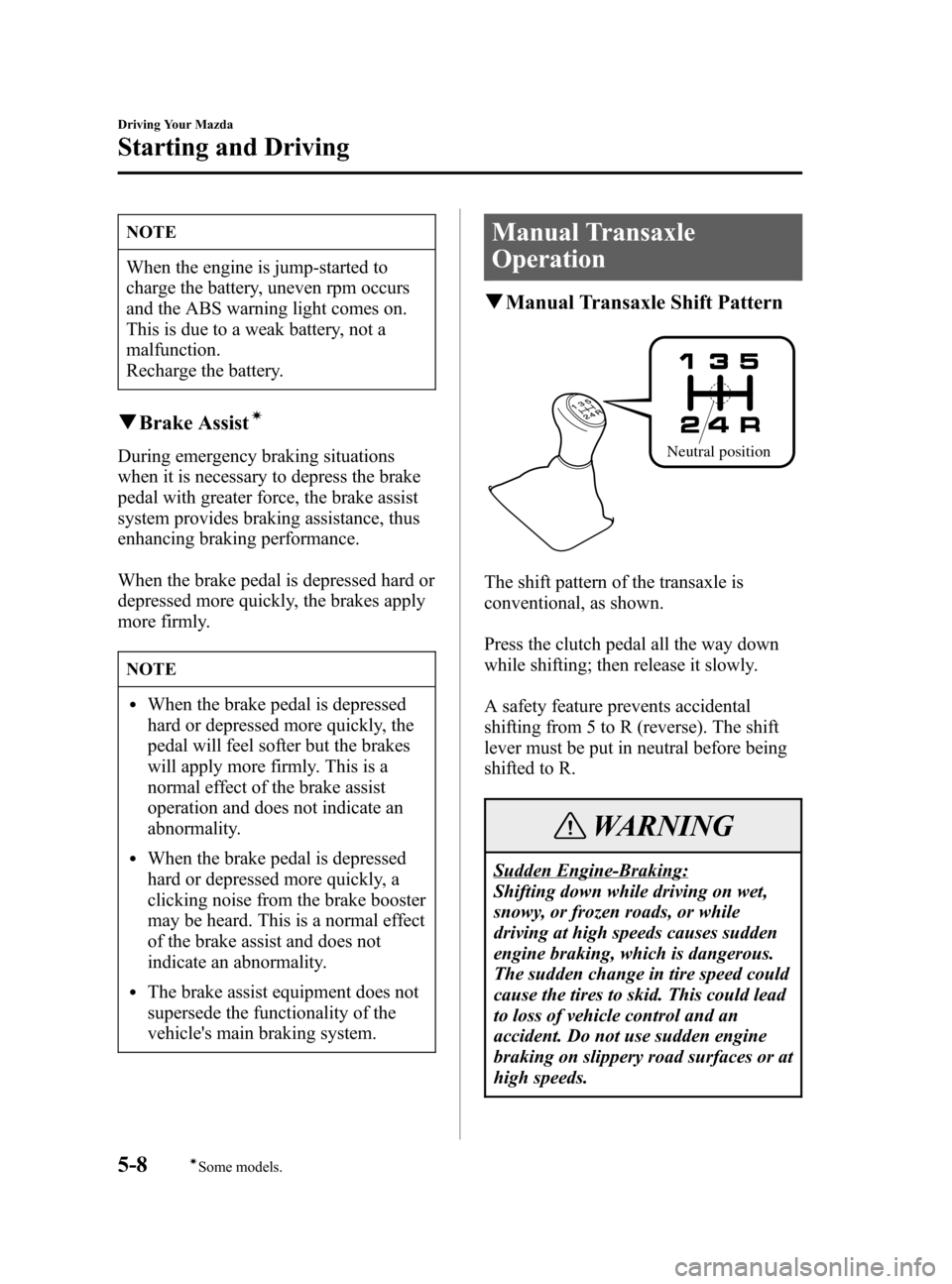
Black plate (118,1)
NOTE
When the engine is jump-started to
charge the battery, uneven rpm occurs
and the ABS warning light comes on.
This is due to a weak battery, not a
malfunction.
Recharge the battery.
qBrake Assistí
During emergency braking situations
when it is necessary to depress the brake
pedal with greater force, the brake assist
system provides braking assistance, thus
enhancing braking performance.
When the brake pedal is depressed hard or
depressed more quickly, the brakes apply
more firmly.
NOTE
lWhen the brake pedal is depressed
hard or depressed more quickly, the
pedal will feel softer but the brakes
will apply more firmly. This is a
normal effect of the brake assist
operation and does not indicate an
abnormality.
lWhen the brake pedal is depressed
hard or depressed more quickly, a
clicking noise from the brake booster
may be heard. This is a normal effect
of the brake assist and does not
indicate an abnormality.
lThe brake assist equipment does not
supersede the functionality of the
vehicle's main braking system.
Manual Transaxle
Operation
qManual Transaxle Shift Pattern
Neutral position
The shift pattern of the transaxle is
conventional, as shown.
Press the clutch pedal all the way down
while shifting; then release it slowly.
A safety feature prevents accidental
shifting from 5 to R (reverse). The shift
lever must be put in neutral before being
shifted to R.
WARNING
Sudden Engine-Braking:
Shifting down while driving on wet,
snowy, or frozen roads, or while
driving at high speeds causes sudden
engine braking, which is dangerous.
The sudden change in tire speed could
cause the tires to skid. This could lead
to loss of vehicle control and an
accident. Do not use sudden engine
braking on slippery road surfaces or at
high speeds.
5-8
Driving Your Mazda
íSome models.
Starting and Driving
Mazda3_8T97-EC-04J_Edition1 Page118
Saturday, September 25 2004 2:10 PM
Form No.8T97-EC-04J
Page 144 of 322
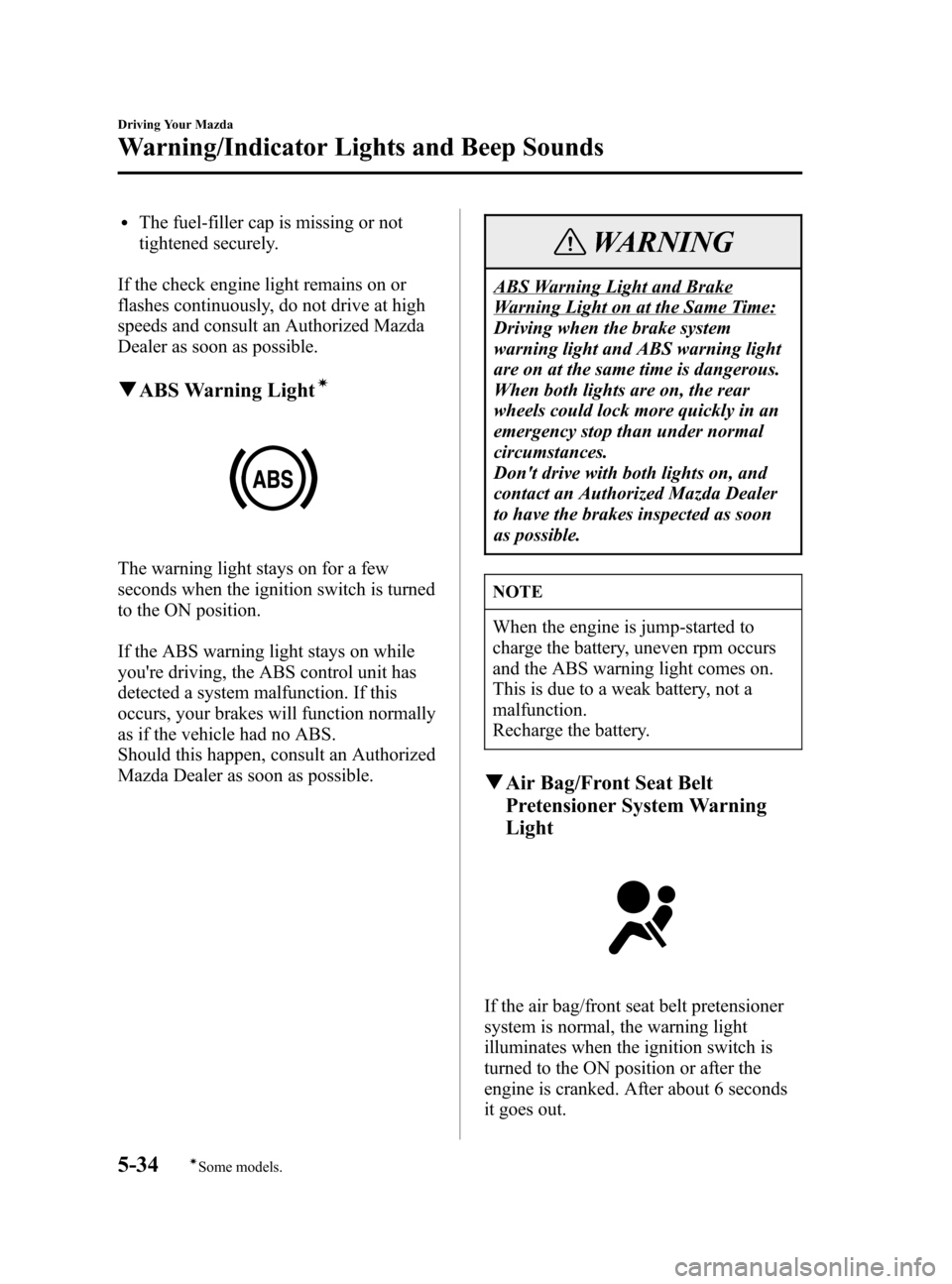
Black plate (144,1)
lThe fuel-filler cap is missing or not
tightened securely.
If the check engine light remains on or
flashes continuously, do not drive at high
speeds and consult an Authorized Mazda
Dealer as soon as possible.
qABS Warning Lightí
The warning light stays on for a few
seconds when the ignition switch is turned
to the ON position.
If the ABS warning light stays on while
you're driving, the ABS control unit has
detected a system malfunction. If this
occurs, your brakes will function normally
as if the vehicle had no ABS.
Should this happen, consult an Authorized
Mazda Dealer as soon as possible.
WARNING
ABS Warning Light and Brake
Warning Light on at the Same Time:
Driving when the brake system
warning light and ABS warning light
are on at the same time is dangerous.
When both lights are on, the rear
wheels could lock more quickly in an
emergency stop than under normal
circumstances.
Don't drive with both lights on, and
contact an Authorized Mazda Dealer
to have the brakes inspected as soon
as possible.
NOTE
When the engine is jump-started to
charge the battery, uneven rpm occurs
and the ABS warning light comes on.
This is due to a weak battery, not a
malfunction.
Recharge the battery.
qAir Bag/Front Seat Belt
Pretensioner System Warning
Light
If the air bag/front seat belt pretensioner
system is normal, the warning light
illuminates when the ignition switch is
turned to the ON position or after the
engine is cranked. After about 6 seconds
it goes out.
5-34
Driving Your Mazda
íSome models.
Warning/Indicator Lights and Beep Sounds
Mazda3_8T97-EC-04J_Edition1 Page144
Saturday, September 25 2004 2:10 PM
Form No.8T97-EC-04J
Page 209 of 322
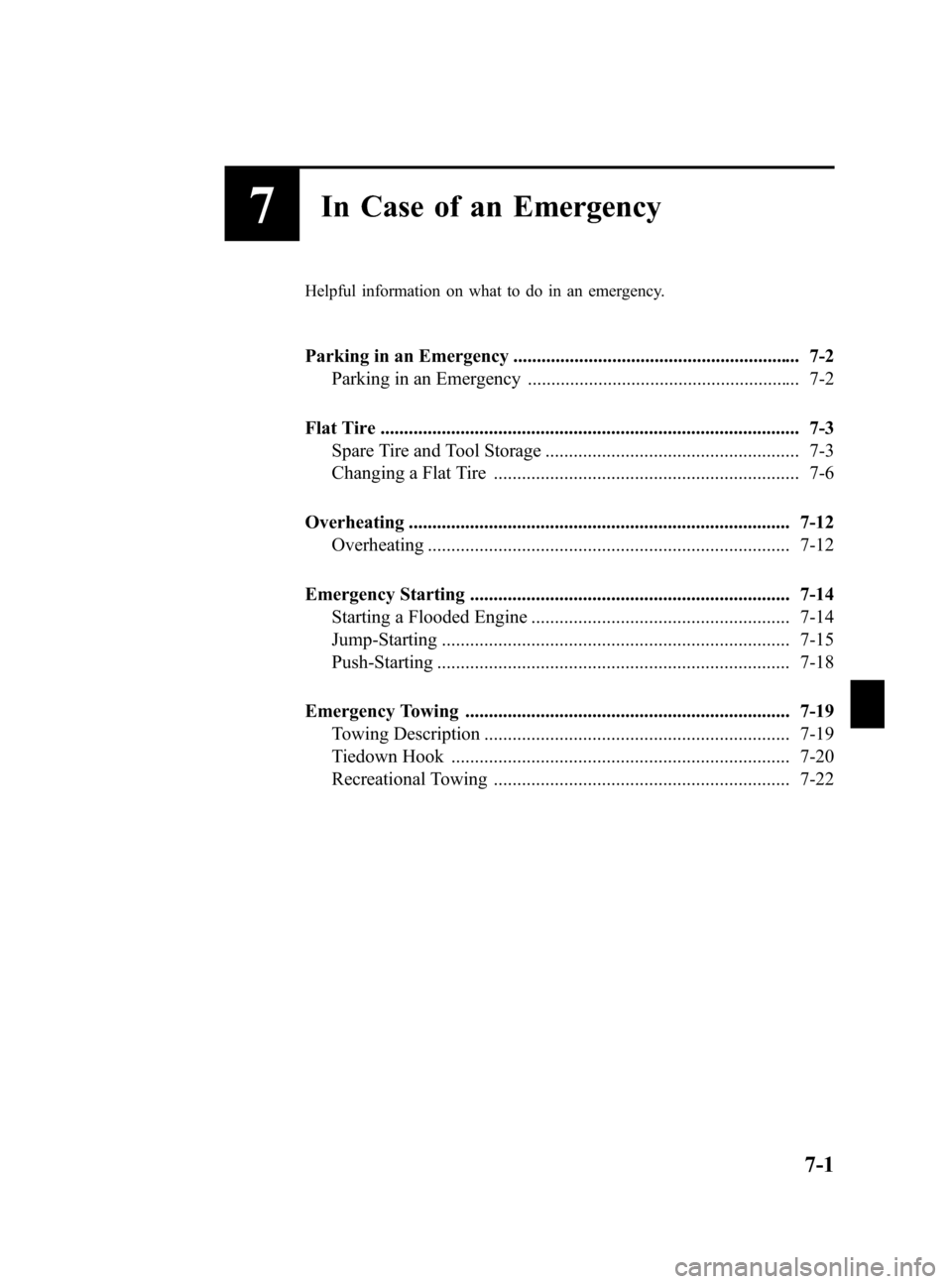
Black plate (209,1)
7In Case of an Emergency
Helpful information on what to do in an emergency.
Parking in an Emergency ............................................................. 7-2
Parking in an Emergency .......................................................... 7-2
Flat Tire ......................................................................................... 7-3
Spare Tire and Tool Storage ...................................................... 7-3
Changing a Flat Tire ................................................................. 7-6
Overheating ................................................................................. 7-12
Overheating ............................................................................. 7-12
Emergency Starting .................................................................... 7-14
Starting a Flooded Engine ....................................................... 7-14
Jump-Starting .......................................................................... 7-15
Push-Starting ........................................................................... 7-18
Emergency Towing ..................................................................... 7-19
Towing Description ................................................................. 7-19
Tiedown Hook ........................................................................ 7-20
Recreational Towing ............................................................... 7-22
7-1
Mazda3_8T97-EC-04J_Edition1 Page209
Saturday, September 25 2004 2:15 PM
Form No.8T97-EC-04J
Page 223 of 322
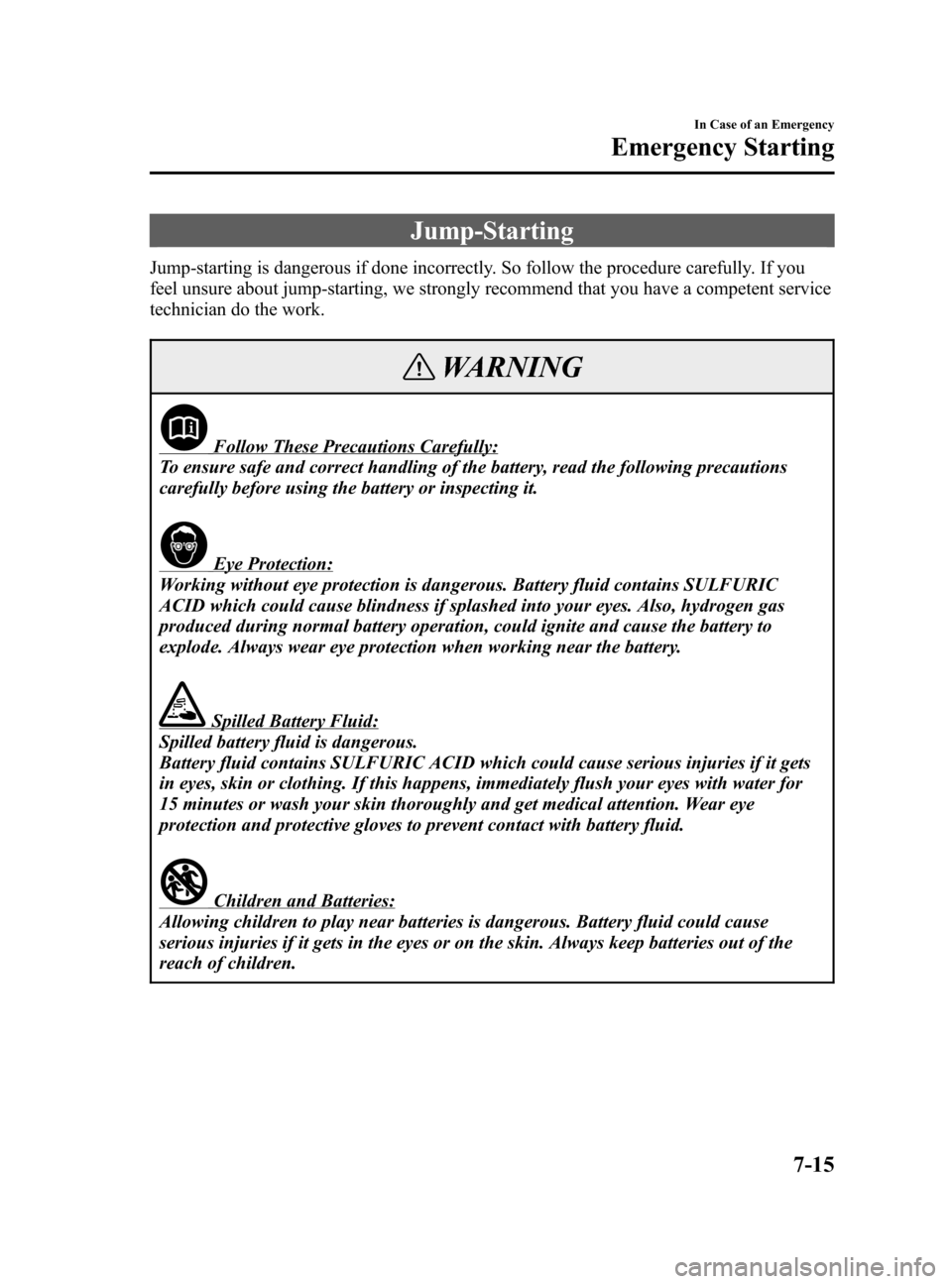
Black plate (223,1)
Jump-Starting
Jump-starting is dangerous if done incorrectly. So follow the procedure carefully. If you
feel unsure about jump-starting, we strongly recommend that you have a competent service
technician do the work.
WARNING
Follow These Precautions Carefully:
To ensure safe and correct handling of the battery, read the following precautions
carefully before using the battery or inspecting it.
Eye Protection:
Working without eye protection is dangerous. Battery fluid contains SULFURIC
ACID which could cause blindness if splashed into your eyes. Also, hydrogen gas
produced during normal battery operation, could ignite and cause the battery to
explode. Always wear eye protection when working near the battery.
Spilled Battery Fluid:
Spilled battery fluid is dangerous.
Battery fluid contains SULFURIC ACID which could cause serious injuries if it gets
in eyes, skin or clothing. If this happens, immediately flush your eyes with water for
15 minutes or wash your skin thoroughly and get medical attention. Wear eye
protection and protective gloves to prevent contact with battery fluid.
Children and Batteries:
Allowing children to play near batteries is dangerous. Battery fluid could cause
serious injuries if it gets in the eyes or on the skin. Always keep batteries out of the
reach of children.
In Case of an Emergency
Emergency Starting
7-15
Mazda3_8T97-EC-04J_Edition1 Page223
Saturday, September 25 2004 2:15 PM
Form No.8T97-EC-04J
Page 224 of 322
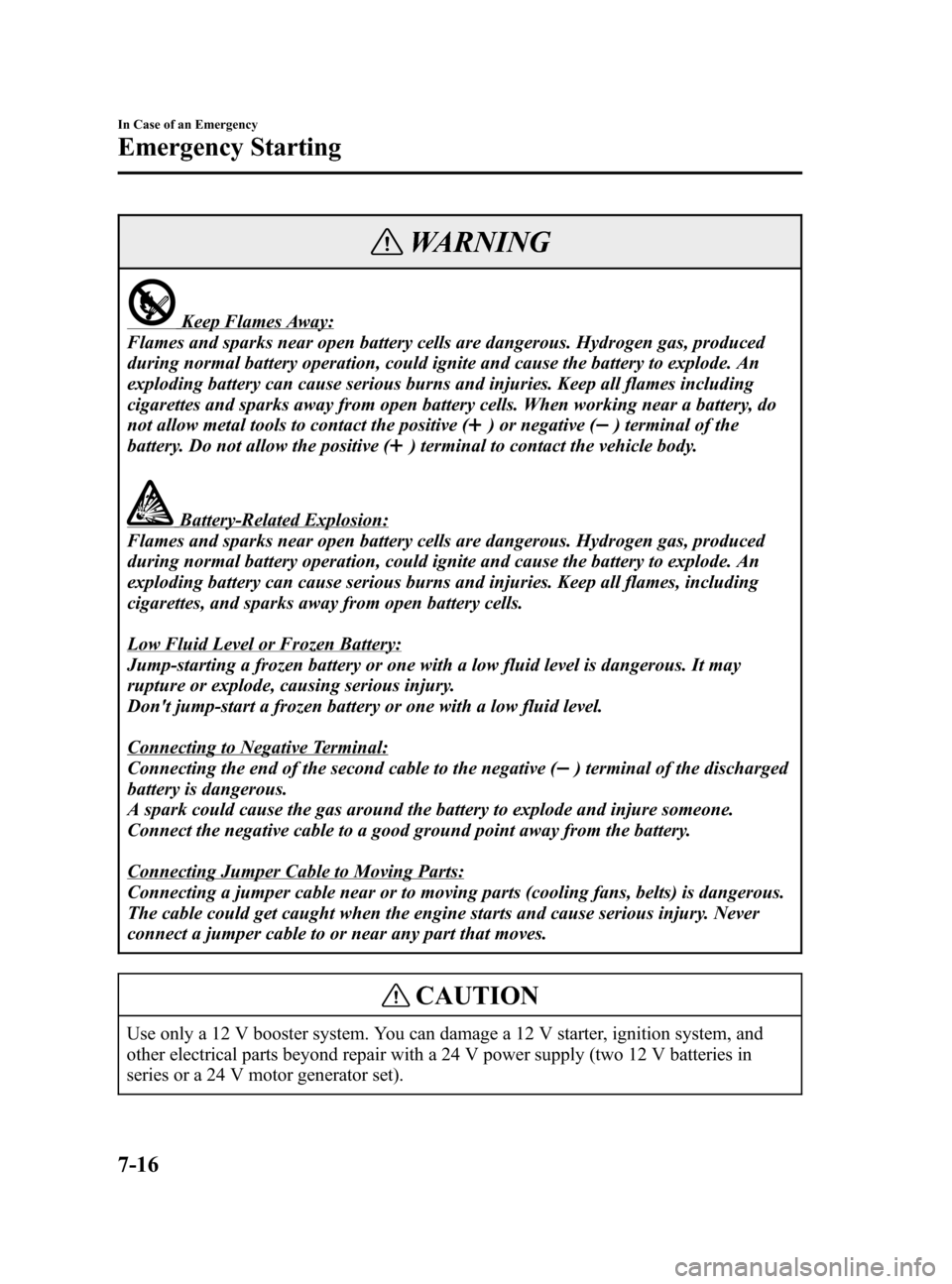
Black plate (224,1)
WARNING
Keep Flames Away:
Flames and sparks near open battery cells are dangerous. Hydrogen gas, produced
during normal battery operation, could ignite and cause the battery to explode. An
exploding battery can cause serious burns and injuries. Keep all flames including
cigarettes and sparks away from open battery cells. When working near a battery, do
not allow metal tools to contact the positive (
) or negative () terminal of the
battery. Do not allow the positive (
) terminal to contact the vehicle body.
Battery-Related Explosion:
Flames and sparks near open battery cells are dangerous. Hydrogen gas, produced
during normal battery operation, could ignite and cause the battery to explode. An
exploding battery can cause serious burns and injuries. Keep all flames, including
cigarettes, and sparks away from open battery cells.
Low Fluid Level or Frozen Battery:
Jump-starting a frozen battery or one with a low fluid level is dangerous. It may
rupture or explode, causing serious injury.
Don't jump-start a frozen battery or one with a low fluid level.
Connecting to Negative Terminal:
Connecting the end of the second cable to the negative (
) terminal of the discharged
battery is dangerous.
A spark could cause the gas around the battery to explode and injure someone.
Connect the negative cable to a good ground point away from the battery.
Connecting Jumper Cable to Moving Parts:
Connecting a jumper cable near or to moving parts (cooling fans, belts) is dangerous.
The cable could get caught when the engine starts and cause serious injury. Never
connect a jumper cable to or near any part that moves.
CAUTION
Use only a 12 V booster system. You can damage a 12 V starter, ignition system, and
other electrical parts beyond repair with a 24 V power supply (two 12 V batteries in
series or a 24 V motor generator set).
7-16
In Case of an Emergency
Emergency Starting
Mazda3_8T97-EC-04J_Edition1 Page224
Saturday, September 25 2004 2:15 PM
Form No.8T97-EC-04J
Page 225 of 322
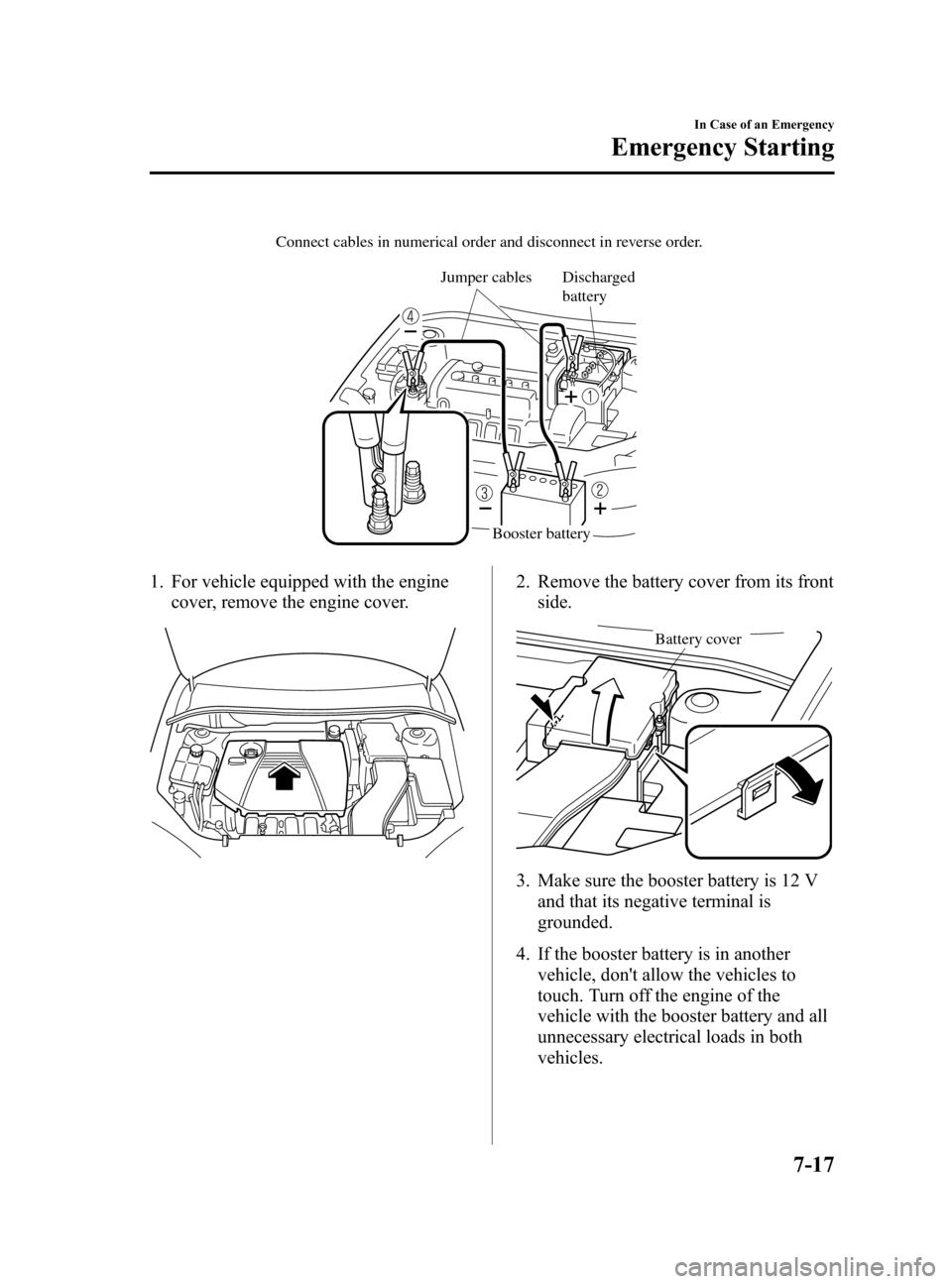
Black plate (225,1)
Connect cables in numerical order and disconnect in reverse order.
Jumper cables Discharged
battery
Booster battery
1. For vehicle equipped with the engine
cover, remove the engine cover.2. Remove the battery cover from its front
side.
Battery cover
3. Make sure the booster battery is 12 V
and that its negative terminal is
grounded.
4. If the booster battery is in another
vehicle, don't allow the vehicles to
touch. Turn off the engine of the
vehicle with the booster battery and all
unnecessary electrical loads in both
vehicles.
In Case of an Emergency
Emergency Starting
7-17
Mazda3_8T97-EC-04J_Edition1 Page225
Saturday, September 25 2004 2:15 PM
Form No.8T97-EC-04J
Page 226 of 322
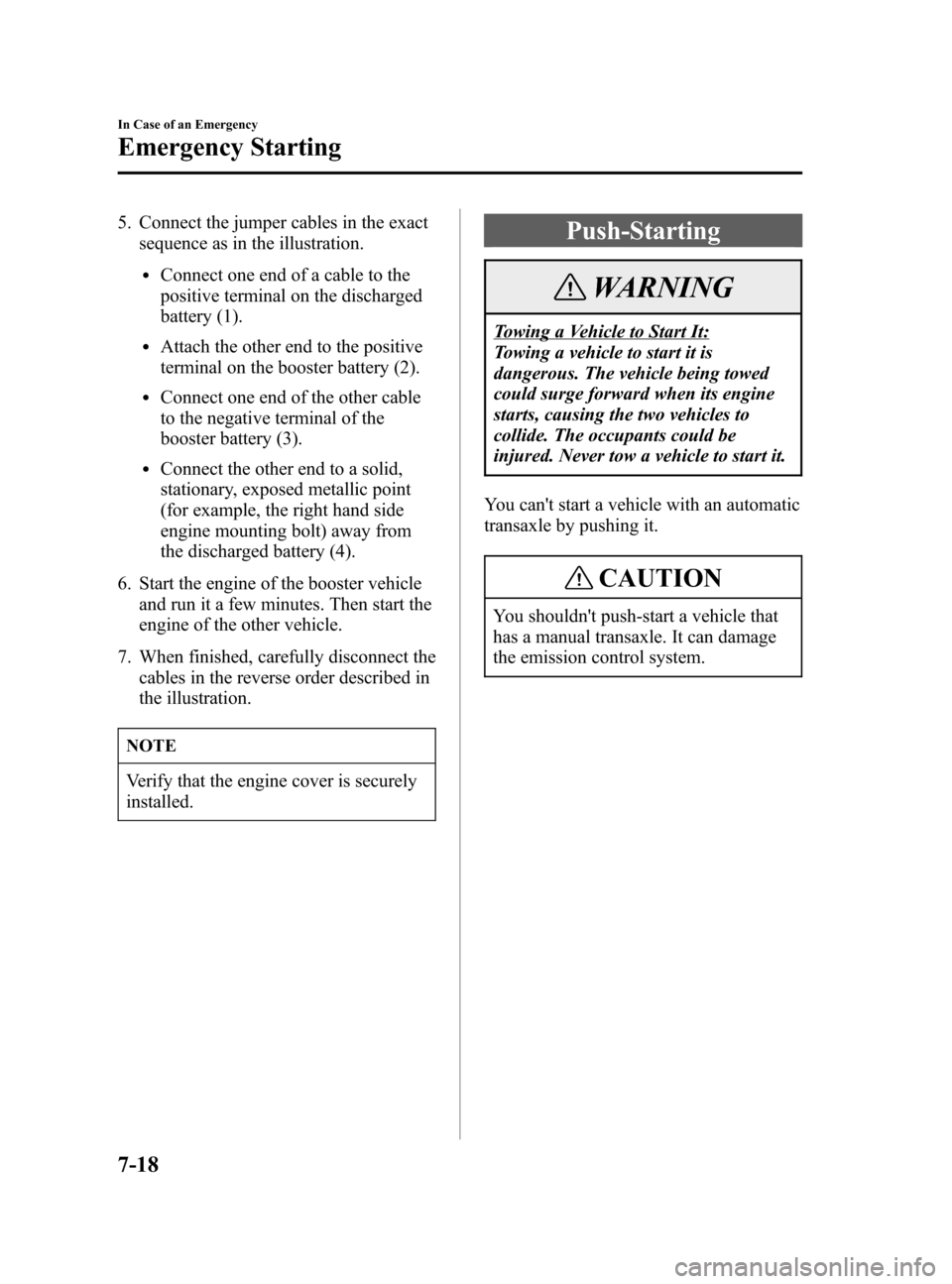
Black plate (226,1)
5. Connect the jumper cables in the exact
sequence as in the illustration.
lConnect one end of a cable to the
positive terminal on the discharged
battery (1).
lAttach the other end to the positive
terminal on the booster battery (2).
lConnect one end of the other cable
to the negative terminal of the
booster battery (3).
lConnect the other end to a solid,
stationary, exposed metallic point
(for example, the right hand side
engine mounting bolt) away from
the discharged battery (4).
6. Start the engine of the booster vehicle
and run it a few minutes. Then start the
engine of the other vehicle.
7. When finished, carefully disconnect the
cables in the reverse order described in
the illustration.
NOTE
Verify that the engine cover is securely
installed.
Push-Starting
WARNING
Towing a Vehicle to Start It:
Towing a vehicle to start it is
dangerous. The vehicle being towed
could surge forward when its engine
starts, causing the two vehicles to
collide. The occupants could be
injured. Never tow a vehicle to start it.
You can't start a vehicle with an automatic
transaxle by pushing it.
CAUTION
You shouldn't push-start a vehicle that
has a manual transaxle. It can damage
the emission control system.
7-18
In Case of an Emergency
Emergency Starting
Mazda3_8T97-EC-04J_Edition1 Page226
Saturday, September 25 2004 2:15 PM
Form No.8T97-EC-04J
Page 319 of 322
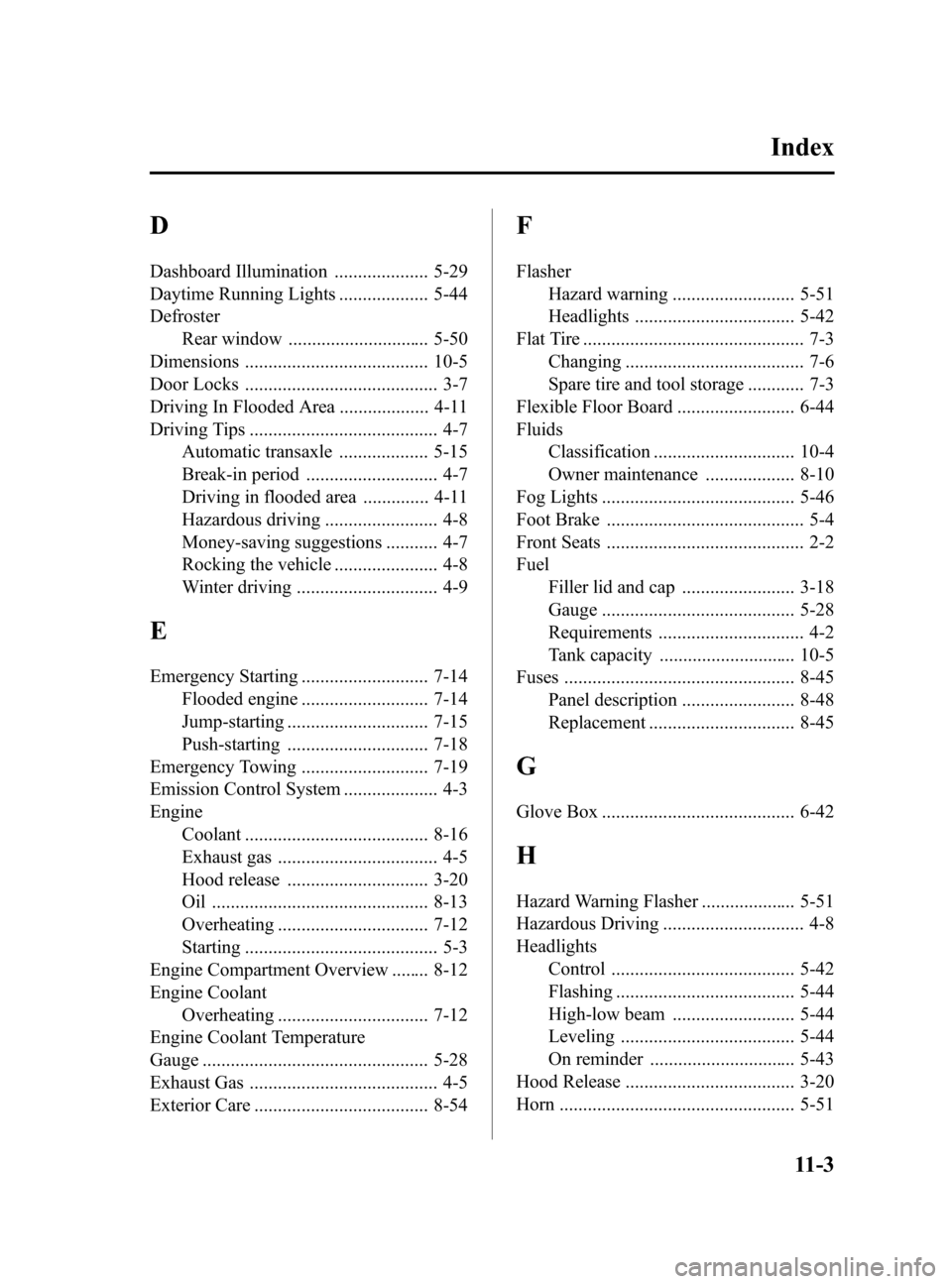
Black plate (319,1)
D
Dashboard Illumination .................... 5-29
Daytime Running Lights ................... 5-44
Defroster
Rear window .............................. 5-50
Dimensions ....................................... 10-5
Door Locks ......................................... 3-7
Driving In Flooded Area ................... 4-11
Driving Tips ........................................ 4-7
Automatic transaxle ................... 5-15
Break-in period ............................ 4-7
Driving in flooded area .............. 4-11
Hazardous driving ........................ 4-8
Money-saving suggestions ........... 4-7
Rocking the vehicle ...................... 4-8
Winter driving .............................. 4-9
E
Emergency Starting ........................... 7-14
Flooded engine ........................... 7-14
Jump-starting .............................. 7-15
Push-starting .............................. 7-18
Emergency Towing ........................... 7-19
Emission Control System .................... 4-3
Engine
Coolant ....................................... 8-16
Exhaust gas .................................. 4-5
Hood release .............................. 3-20
Oil .............................................. 8-13
Overheating ................................ 7-12
Starting ......................................... 5-3
Engine Compartment Overview ........ 8-12
Engine Coolant
Overheating ................................ 7-12
Engine Coolant Temperature
Gauge ................................................ 5-28
Exhaust Gas ........................................ 4-5
Exterior Care ..................................... 8-54
F
Flasher
Hazard warning .......................... 5-51
Headlights .................................. 5-42
Flat Tire ............................................... 7-3
Changing ...................................... 7-6
Spare tire and tool storage ............ 7-3
Flexible Floor Board ......................... 6-44
Fluids
Classification .............................. 10-4
Owner maintenance ................... 8-10
Fog Lights ......................................... 5-46
Foot Brake .......................................... 5-4
Front Seats .......................................... 2-2
Fuel
Filler lid and cap ........................ 3-18
Gauge ......................................... 5-28
Requirements ............................... 4-2
Tank capacity ............................. 10-5
Fuses ................................................. 8-45
Panel description ........................ 8-48
Replacement ............................... 8-45
G
Glove Box ......................................... 6-42
H
Hazard Warning Flasher .................... 5-51
Hazardous Driving .............................. 4-8
Headlights
Control ....................................... 5-42
Flashing ...................................... 5-44
High-low beam .......................... 5-44
Leveling ..................................... 5-44
On reminder ............................... 5-43
Hood Release .................................... 3-20
Horn .................................................. 5-51
Index
11-3
Mazda3_8T97-EC-04J_Edition1 Page319
Saturday, September 25 2004 2:17 PM
Form No.8T97-EC-04J
Page 320 of 322
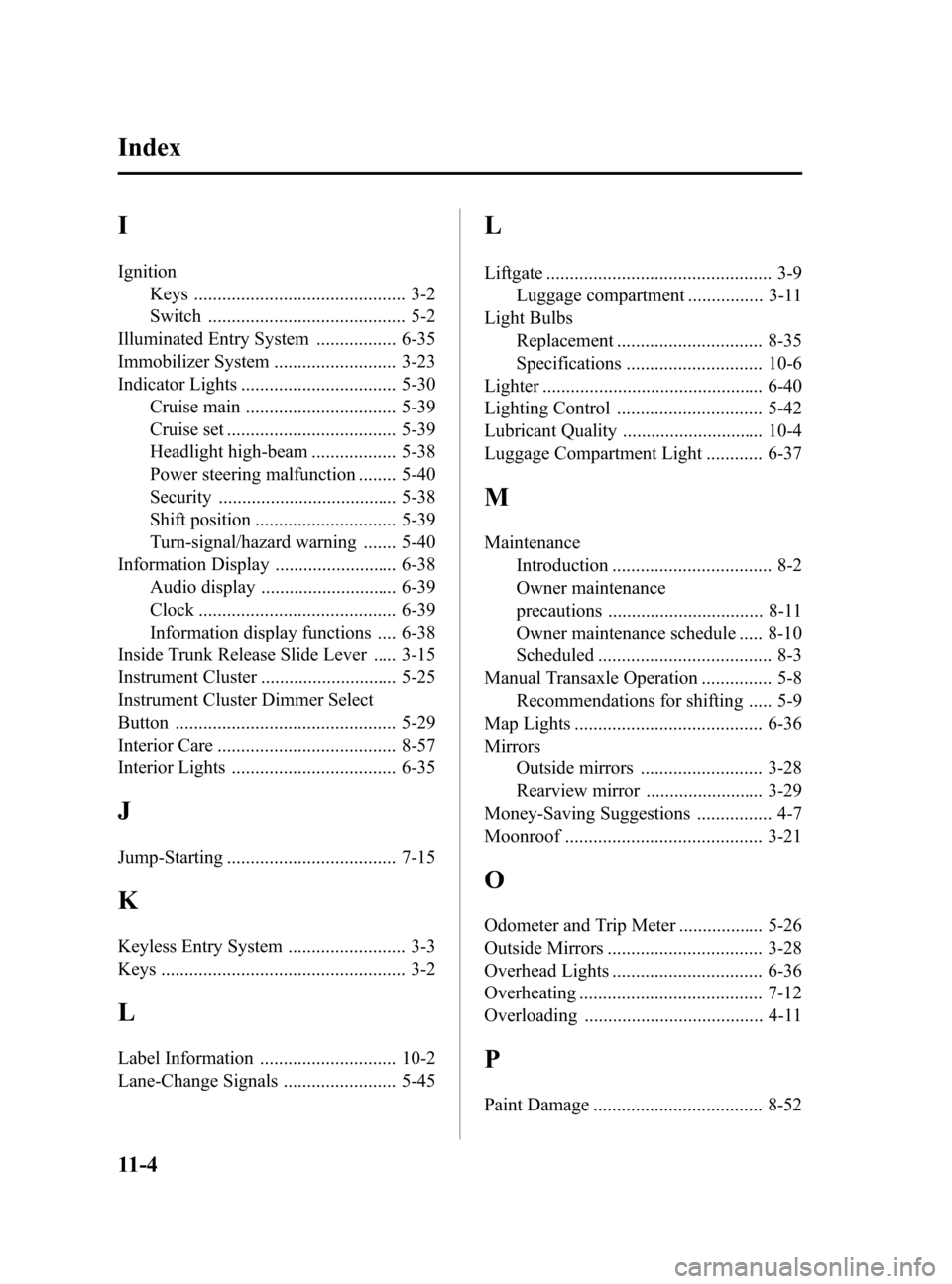
Black plate (320,1)
I
Ignition
Keys ............................................. 3-2
Switch .......................................... 5-2
Illuminated Entry System ................. 6-35
Immobilizer System .......................... 3-23
Indicator Lights ................................. 5-30
Cruise main ................................ 5-39
Cruise set .................................... 5-39
Headlight high-beam .................. 5-38
Power steering malfunction ........ 5-40
Security ...................................... 5-38
Shift position .............................. 5-39
Turn-signal/hazard warning ....... 5-40
Information Display .......................... 6-38
Audio display ............................. 6-39
Clock .......................................... 6-39
Information display functions .... 6-38
Inside Trunk Release Slide Lever ..... 3-15
Instrument Cluster ............................. 5-25
Instrument Cluster Dimmer Select
Button ............................................... 5-29
Interior Care ...................................... 8-57
Interior Lights ................................... 6-35
J
Jump-Starting .................................... 7-15
K
Keyless Entry System ......................... 3-3
Keys .................................................... 3-2
L
Label Information ............................. 10-2
Lane-Change Signals ........................ 5-45
L
Liftgate ................................................ 3-9
Luggage compartment ................ 3-11
Light Bulbs
Replacement ............................... 8-35
Specifications ............................. 10-6
Lighter ............................................... 6-40
Lighting Control ............................... 5-42
Lubricant Quality .............................. 10-4
Luggage Compartment Light ............ 6-37
M
Maintenance
Introduction .................................. 8-2
Owner maintenance
precautions ................................. 8-11
Owner maintenance schedule ..... 8-10
Scheduled ..................................... 8-3
Manual Transaxle Operation ............... 5-8
Recommendations for shifting ..... 5-9
Map Lights ........................................ 6-36
Mirrors
Outside mirrors .......................... 3-28
Rearview mirror ......................... 3-29
Money-Saving Suggestions ................ 4-7
Moonroof .......................................... 3-21
O
Odometer and Trip Meter .................. 5-26
Outside Mirrors ................................. 3-28
Overhead Lights ................................ 6-36
Overheating ....................................... 7-12
Overloading ...................................... 4-11
P
Paint Damage .................................... 8-52
11-4
Index
Mazda3_8T97-EC-04J_Edition1 Page320
Saturday, September 25 2004 2:17 PM
Form No.8T97-EC-04J